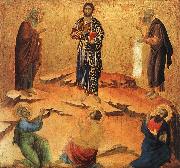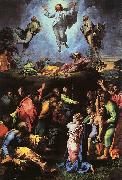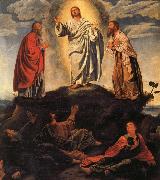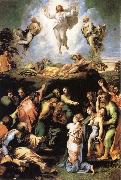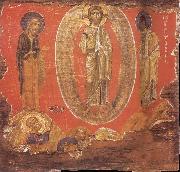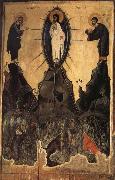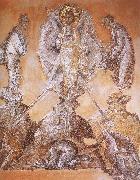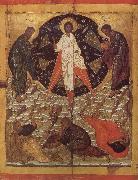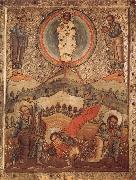Wholesale Oil Painting No Minimum |
|||||||||||
|
|
|||||||||||

|
|||||||||||
|
|
|
||||||||
Duccio di Buoninsegna1255-1318 Italian Duccio di Buoninsegna Locations Italian painter. He was one of the most important painters of the 14th century and like his slightly younger contemporary, Giotto, was a major influence on the course of Italian painting. An innovator, he introduced into Sienese painting new altarpiece designs, a dramatic use of landscape, expressive emotional relationships, extremely complex spatial structures and a subtle interplay of colour. His most important and revolutionary work, the Maeste for Siena Cathedral, was never matched during the 14th century, if at all, and his influence lasted well into the 15th century. |
||||||||
|
|
||||||||
The Transfiguration
The Transfiguration Painting ID:: 266 |
1308-11
National Gallery, London 1308-11 National Gallery, London |
|||||||
|
|
||||||||
RaphaelItalian High Renaissance Painter, 1483-1520 Raphael Sanzio, usually known by his first name alone (in Italian Raffaello) (April 6 or March 28, 1483 ?C April 6, 1520), was an Italian painter and architect of the High Renaissance, celebrated for the perfection and grace of his paintings and drawings. Together with Michelangelo and Leonardo da Vinci, he forms the traditional trinity of great masters of that period. Raphael was enormously productive, running an unusually large workshop, and, despite his early death at thirty-seven, a large body of his work remains, especially in the Vatican, whose frescoed Raphael Rooms were the central, and the largest, work of his career, although unfinished at his death. After his early years in Rome, much of his work was designed by him and executed largely by the workshop from his drawings, with considerable loss of quality. He was extremely influential in his lifetime, though outside Rome his work was mostly known from his collaborative printmaking. After his death, the influence of his great rival Michelangelo was more widespread until the 18th and 19th centuries, when Raphael's more serene and harmonious qualities were again regarded as the highest models. His career falls naturally into three phases and three styles, first described by Giorgio Vasari: his early years in Umbria, then a period of about four years (from 1504-1508) absorbing the artistic traditions of Florence, followed by his last hectic and triumphant twelve years in Rome, working for two Popes and their close associates. |
||||||||
|
|
||||||||
|
|
The Transfiguration
The Transfiguration Painting ID:: 3317 |
The Vatican The Vatican |
||||||
|
|
||||||||
RaphaelItalian High Renaissance Painter, 1483-1520 Raphael Sanzio, usually known by his first name alone (in Italian Raffaello) (April 6 or March 28, 1483 ?C April 6, 1520), was an Italian painter and architect of the High Renaissance, celebrated for the perfection and grace of his paintings and drawings. Together with Michelangelo and Leonardo da Vinci, he forms the traditional trinity of great masters of that period. Raphael was enormously productive, running an unusually large workshop, and, despite his early death at thirty-seven, a large body of his work remains, especially in the Vatican, whose frescoed Raphael Rooms were the central, and the largest, work of his career, although unfinished at his death. After his early years in Rome, much of his work was designed by him and executed largely by the workshop from his drawings, with considerable loss of quality. He was extremely influential in his lifetime, though outside Rome his work was mostly known from his collaborative printmaking. After his death, the influence of his great rival Michelangelo was more widespread until the 18th and 19th centuries, when Raphael's more serene and harmonious qualities were again regarded as the highest models. His career falls naturally into three phases and three styles, first described by Giorgio Vasari: his early years in Umbria, then a period of about four years (from 1504-1508) absorbing the artistic traditions of Florence, followed by his last hectic and triumphant twelve years in Rome, working for two Popes and their close associates. |
||||||||
|
|
||||||||
|
|
The Transfiguration
The Transfiguration Painting ID:: 3318 |
The Vatican The Vatican |
||||||
|
|
||||||||
Giovanni Gerolamo SavoldoItalian Mannerist Painter , c. 1480 - aft.1548 was an Italian High Renaissance painter. Savoldo was born in Brescia, but little is known about his early years. Some sources claim he was known as Girolamo Bresciano. By 1506 he was in Parma, and by 1508, he had joined the Florentine painter??s guild. In this period he finished the Rest at the Flight from Egypt (Augsburg), the Elijah Harassed by a Crow (National Gallery of Art, Washington), and a Deposition. In 1515 he painted the Portrait of a Clad Warrior, wrongly identified with Gaston de Foix. Also from the same period his the Temptings of St. Anthony, which appears to show the influence of the Flemish Hieronymus Bosch. The works was appreciated by the commissioners from Venice, where Savoldo relocated before 1520. On June 15, 1524 he signed a contract for an altarpiece for the church of San Domenico in Pesaro (now in the Brera, Milan). In 1527, he completed a St. Hieronymus for the Brescian family Averoldi, probably the one at National Gallery of London. From the 1530s dates a Nativity at the National Gallery in Washington DC, which seems influenced by the lambent contemporary, Correggio painting on the same topic. In 1533 Savoldo painted a Madonna with Four Saints in the church of Santa Maria in Organo, while in 1537-1538 he executed the altarpiece for the main altar of Santa Croce, Brescia. |
||||||||
|
|
||||||||
|
|
The Transfiguration
The Transfiguration Painting ID:: 29904 |
mk67
Panel
54 3/4x495/8in
Uffizi,Gallery
mk67 Panel 54 3/4x495/8in Uffizi,Gallery |
||||||
|
|
||||||||
PERUGINO, PietroItalian painter, Umbrian school (b. 1450, Citta della Pieve, d. 1523, Perugia). Italian painter and draughtsman. He was active in Perugia, Florence and Rome in the late 15th century and early 16th. Although he is now known mainly as the teacher of Raphael, he made a significant contribution to the development of painting from the style of the Early Renaissance to the High Renaissance. The compositional model he introduced, combining the Florentine figural style with an Umbrian use of structure and space, |
||||||||
|
|
||||||||
|
|
The Transfiguration
The Transfiguration Painting ID:: 32454 |
1498
Fresco, 226 x 229 cm 1498 Fresco, 226 x 229 cm |
||||||
|
|
||||||||
RaphaelItalian High Renaissance Painter, 1483-1520 Raphael Sanzio, usually known by his first name alone (in Italian Raffaello) (April 6 or March 28, 1483 ?C April 6, 1520), was an Italian painter and architect of the High Renaissance, celebrated for the perfection and grace of his paintings and drawings. Together with Michelangelo and Leonardo da Vinci, he forms the traditional trinity of great masters of that period. Raphael was enormously productive, running an unusually large workshop, and, despite his early death at thirty-seven, a large body of his work remains, especially in the Vatican, whose frescoed Raphael Rooms were the central, and the largest, work of his career, although unfinished at his death. After his early years in Rome, much of his work was designed by him and executed largely by the workshop from his drawings, with considerable loss of quality. He was extremely influential in his lifetime, though outside Rome his work was mostly known from his collaborative printmaking. After his death, the influence of his great rival Michelangelo was more widespread until the 18th and 19th centuries, when Raphael's more serene and harmonious qualities were again regarded as the highest models. His career falls naturally into three phases and three styles, first described by Giorgio Vasari: his early years in Umbria, then a period of about four years (from 1504-1508) absorbing the artistic traditions of Florence, followed by his last hectic and triumphant twelve years in Rome, working for two Popes and their close associates. |
||||||||
|
|
||||||||
|
|
The Transfiguration
The Transfiguration Painting ID:: 33482 |
mk86
c.1517-1520
Oil on canvas
405x278cm
Rome,Musei Vaticani,
Pinacoteca Vaticana
mk86 c.1517-1520 Oil on canvas 405x278cm Rome,Musei Vaticani, Pinacoteca Vaticana |
||||||
|
|
||||||||
|
|
||||||||
|
|
The Transfiguration
The Transfiguration Painting ID:: 41812 |
mk165
23.2x23.7cm
The State Hermitage Museum
St.Petersburg
mk165 23.2x23.7cm The State Hermitage Museum St.Petersburg |
||||||
|
|
||||||||
|
|
||||||||
|
|
The Transfiguration
The Transfiguration Painting ID:: 41830 |
mk165
Egg tempera on wood
154x101cm
mk165 Egg tempera on wood 154x101cm |
||||||
|
|
||||||||
|
|
||||||||
|
|
The Transfiguration
The Transfiguration Painting ID:: 41835 |
mk165
Byzantine Mosaic
Church of the Saints-Apostles
Thessalonica
mk165 Byzantine Mosaic Church of the Saints-Apostles Thessalonica |
||||||
|
|
||||||||
|
|
||||||||
|
|
The Transfiguration
The Transfiguration Painting ID:: 41877 |
mk165
Moscow
71x55cm
THe State tretyakov gallery
mk165 Moscow 71x55cm THe State tretyakov gallery |
||||||
|
|
||||||||
|
|
||||||||
|
|
The Transfiguration
The Transfiguration Painting ID:: 41878 |
mk165
Lviv
Ukraine
mk165 Lviv Ukraine |
||||||
|
|
||||||||
|
unknow artist The Transfiguration mk165 Lviv Ukraine |
||||||||
|
|
||||||||
|
Prev Next
|
||||||||
|
|
||||||||
|
Related Paintings to unknow artist :. |
||||||||
|
|
||||||||
|
CONTACT US |
